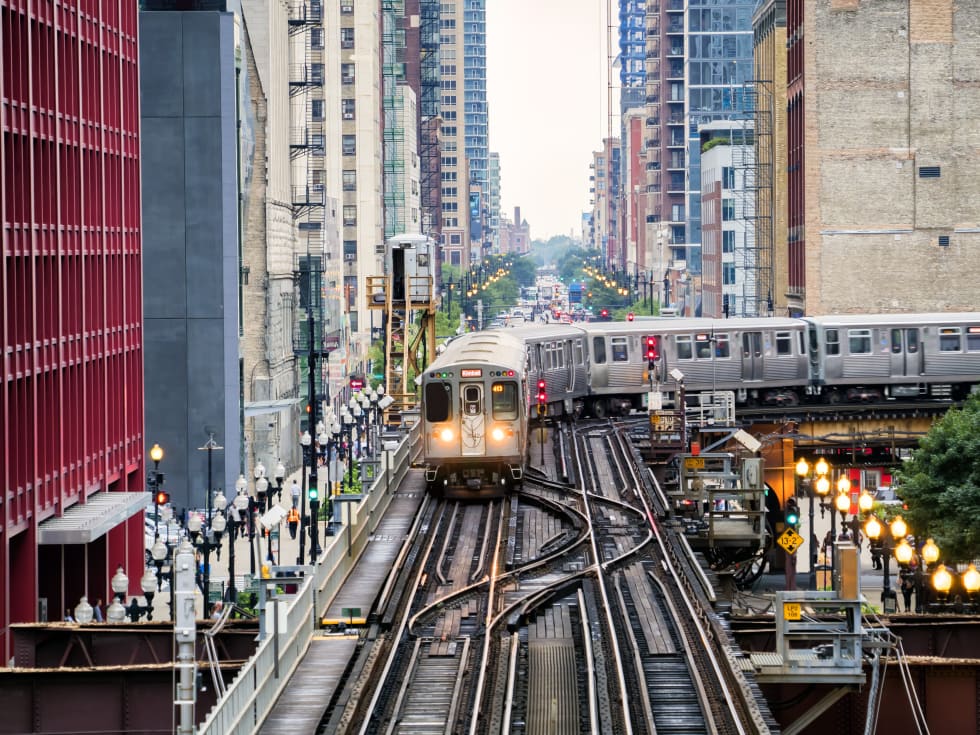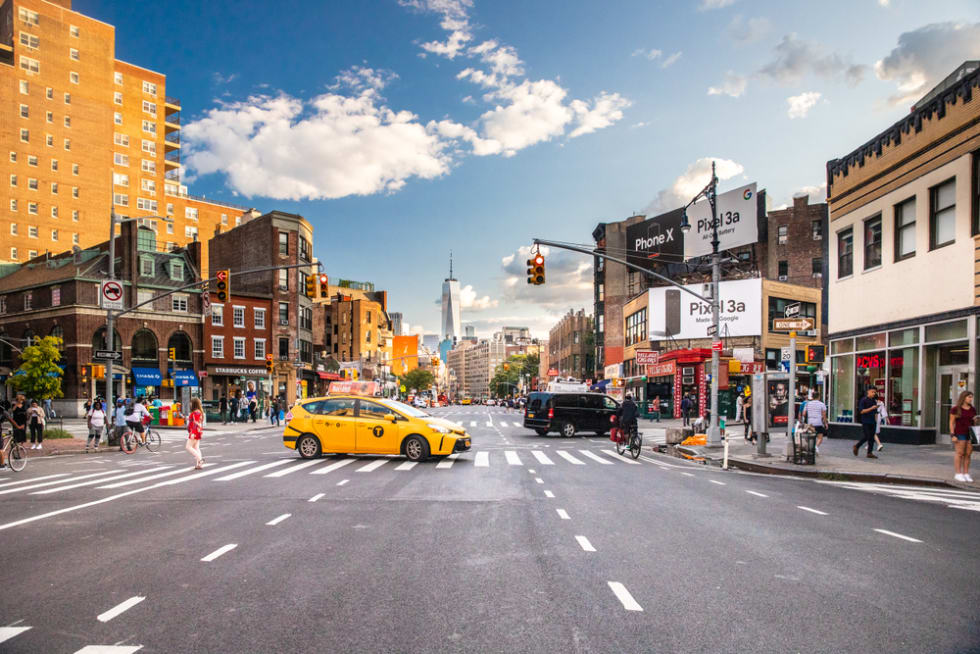The Pembroke
- 113 units available
- 1 bed • 2 bed
- Amenities
In unit laundry, Granite counters, Hardwood floors, Dishwasher, Pet friendly, 24hr maintenance + more

You can find apartments near public transportation by combining transit maps, our latest rental data, and neighborhood research to confirm commute times, affordability, and safety before signing a lease. Living near reliable bus, subway, or rail lines can reduce your need for a car, cut commuting and parking costs, and keep you better connected to work, school, and entertainment.
Finding a transit-accessible apartment doesn’t have to be overwhelming. With the right strategy and tools, you can compare neighborhoods, evaluate affordability, and confirm that your new home is just steps away from the trains or buses you’ll rely on.
Living near public transit helps renters save money on transportation, reduce commute times, and enjoy greater convenience and walkability. For many renters, public transit can mean the difference between spending hours stuck in traffic or having a stress-free, predictable commute.
The financial benefits are also significant. The average cost of owning a vehicle in the U.S. is over $12,000 per year once you factor in monthly car payments, insurance, gas, and maintenance. Renters who live near public transit may be able to downsize to one car or even go car-free altogether to save thousands each year.
Transit hubs are often situated near restaurants, grocery stores, college campuses, and entertainment options. Living near public transit often overlaps with living in a more vibrant, convenient neighborhood.
The best way to start your apartment search near public transit is to review city transit maps and Google Maps routes to see where subway, bus, and rail lines are located. Every metro area is different: some cities rely heavily on buses, while others have robust rail systems.
How to research transit options:
By overlaying transit maps with rental listings, you’ll start to see which neighborhoods provide the best balance of affordability and access.
You can also look for apartments near public transit by using Apartment List’s interactive maps and neighborhood filters to narrow listings to transit-accessible areas. You can zoom into a city map, view apartments near specific stations, and filter results based on your budget and preferred amenities.
It’s a more efficient process than manually cross-checking apartments against transit maps. You’ll immediately see which apartments fall within walking distance of key bus routes or rail lines, which should help you narrow your search before scheduling tours.
Apartments near transit typically often cost more, so compare neighborhood rent prices against citywide averages to confirm if the convenience is worth the premium. Proximity to a major subway station or commuter rail hub typically raises demand and your monthly rent.
Examples from our latest 2025 Apartment List data:
| City | Average One-Bedroom Rent | Average Two-Bedroom Rent |
|---|---|---|
| New York | $5,530 | $9,346 |
| Atlanta | $1,804 | $2,270 |
| Chicago | $2,274 | $2,870 |
| San Francisco | $3,460 | $4,973 |
| Austin | $1,519 | $1,914 |
You can also browse our national and local rent reports to get an idea of the latest rental data and year-over-year rental trends. When evaluating listings, ask yourself: does the added rent cost offset what you’d otherwise spend on gas, car payments, and parking? For many renters, the answer is yes. When you live near transit, you can actually be the more affordable long-term option.

Always calculate commute time at peak hours on Google Maps or Citymapper to see if living near a transit line actually saves time. An apartment may be near a train station, but that doesn’t guarantee a shorter commute if multiple transfers or delays are common.
Run a few test commutes:
If two apartments have similar rent but one requires multiple transfers, choose the one with the simplest commute, even if it costs slightly more. You’ll be glad you saved yourself the stress.
Transit-friendly living isn’t just about convenience; it’s also about accessibility. If you or someone in your household relies on mobility aids, stroller access, or ADA accommodations, it’s important to evaluate whether your target neighborhood’s transit system meets those needs.
Things to check:
Proactively checking accessibility ensures your transit proximity is truly useful in real life, not just on paper.
A transit-friendly apartment only works if you can easily reach the station, so check WalkScore and local bike maps for safe, walkable routes.
Walkability matters because:
Check out our latest city guides and “walkable neighborhood” series to make it easier to compare neighborhoods.

The total cost of living near transit includes utilities, groceries, and transportation expenses, not just rent, so factor these in before deciding.
For example:
Use our Cost of Living Calculator to compare full affordability across neighborhoods, not just rent. But it’s still important to figure out how much you can actually afford for an apartment.
We also recommend using the 30% rule to keep housing costs manageable. For example, if you earn $5,000 a month, you should budget around $1,500 for rent. We also continuously update our Cost of Living city guides to make it easier to plan your next move.
An apartment advertised as “steps from transit” may actually be a red flag. It could be a warning that you’re going to experience drawbacks like noise, crime near stations, or outdated buildings. Review listings carefully and cross-reference with online reviews.
Red flags to watch for:
Always cross-check our apartment reviews, city inspection reports, and local forums before signing a lease.
Check neighborhood crime maps and safety reports to confirm whether or not transit hubs nearby affect the overall security of the area.
Transit-adjacent areas may experience higher rates of petty theft or vandalism, even if they’re otherwise safe. Compare local crime statistics with citywide averages, and visit in person at night to see how safe it feels.
Our latest Safest Neighborhoods guides are a great resource to cross-reference safety and rent affordability before committing.
Visiting a transit-accessible neighborhood in person will give you a better idea of how safe, busy, and practical the commute will be at different times of day.
When visiting a neighborhood:
If a neighborhood feels unsafe or inconvenient, trust your instincts, even if the apartment looks great online.
Talking to locals about public transit reliability and neighborhood safety gives you real-world feedback beyond what data and maps can show.
Questions to ask:
Neighborhood Facebook groups, Reddit threads, and casual conversations with nearby residents can reveal insights you won’t find in listings.
Even if you live near a reliable bus or train line, it’s smart to have a backup transportation plan in case of delays, service outages, or late-night trips. Most large cities have ride-hailing services like Uber and Lyft, but the costs can add up quickly if you rely on them too often.
Before signing a lease, check average rideshare fares from your potential neighborhood to your workplace, airport, or downtown area so you know what to expect.

Before you make your final decision, think through the noise and lifestyle options. Living close to transit brings convenience, but it can also come with noise and foot traffic. This trade-off is highly personal. What one renter sees as a lively, connected neighborhood, another might find stressful.
Consider:
Balancing convenience with comfort is key, but sometimes a slightly longer walk to transit is worth the added peace and quiet.
Finding apartments near public transportation requires balancing rent, commute efficiency, safety, and lifestyle fit. By using Apartment List’s rent reports, cost of living calculator, and neighborhood guides, you’ll have the data to make a confident decision.
Ready to find apartments near public transit? Take the Apartment List quiz today. In five minutes, you’ll be matched with rentals that fit your budget, lifestyle, and commuting needs.
Yes, apartments near public transportation typically rent for more money. However, many renters find the cost worthwhile when balanced against gas, parking, and car ownership expenses.
To determine if a neighborhood has good transit, check the local transit authority’s website, Transit Score, and apps like Google Maps, Transit, or Moovit. These tools show frequency, reliability, and accessibility in real time.
When looking for a transit-friendly apartment, you should prioritize a safe walking route to the station. Reliable service frequency, ADA access, and an apartment building that matches your lifestyle needs are also important.
Most renters consider a 5- to 10 minute walk (about ¼ to ½ mile) to public transportation a sweet spot. Beyond that, convenience drops, especially in bad weather or at night.
Yes, but check night and weekend schedules carefully. If transit shuts down early, factor in the cost of rideshares as a backup plan. You should also consider the safety of the transit in the area.
Yes, apartments near transit can sometimes have higher turnover. High demand near transit can create more competition and frequent moves. On the upside, if you ever need to sublet, transit-adjacent units often attract renters quickly.
Whether or not an apartment is both public transit-accessible is safe depends on the neighborhood. Busy areas can deter crime but also attract petty theft near stations. Always review crime maps, check lighting, and tour the neighborhood at night before deciding.

In unit laundry, Granite counters, Hardwood floors, Dishwasher, Pet friendly, 24hr maintenance + more
In unit laundry, Patio / balcony, Granite counters, Pet friendly, Stainless steel, Walk in closets + more